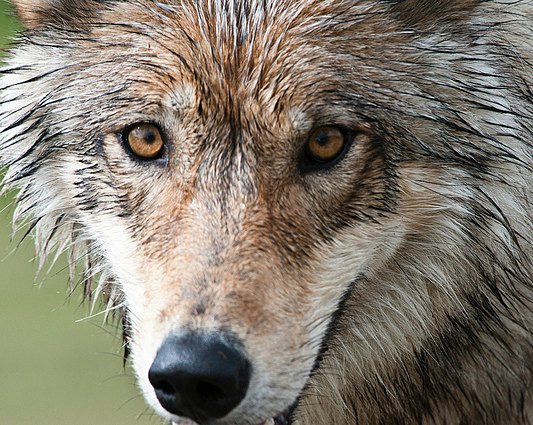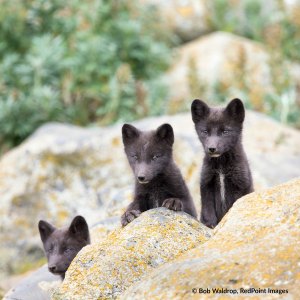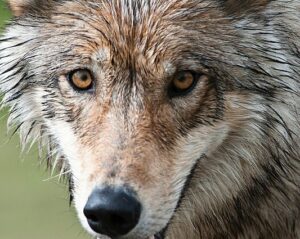
Predator control in Alaska
“You can’t let nature run wild: predator control in Alaska” by Peter Van Tuyn was first published on the American College of Environmental Lawyers website on March 28, 2017. It is published here with ACEL and the author’s permission.
You can’t let nature run wild: predator control in Alaska
Seeking to explain Alaska’s aggressive predator control policies, Alaska Governor Wally Hickel famously said in the early 1990s that “you can’t let nature run wild.” In Alaska this means that wildlife management is focused on maximizing the number of some human prey species such as deer, caribou and moose, by allowing the killing of bears and wolves that also prey on those animals. A majority in the current United States Congress apparently agree with Alaska’s predator control approach to wildlife management, at least as it might apply in our nation’s largest national wildlife refuges within Alaska’s borders.
Congress this week sent to the president’s desk a Congressional Review Act resolution rejecting a 2016 U.S. Fish and Wildlife Service rule that banned aggressive state sport hunting practices designed to reduce populations of predators on state land. The rule banned just the most egregious of these practices on the roughly 77 million acres of national wildlife refuge land in Alaska. (Editor’s note: the President has since signed the resolution.)
The blunt tool used to gut protections
 The Congressional Review Act is a legislative instrument which Congress can use to reject in the whole recently-passed federal rules. This blunt “up or down” action is not subject to filibuster in the Senate, and if a rule is rejected through this process agencies are prohibited from passing “substantially similar” rules in the future. Prior to the 115th Congress the Congressional Review Act had only successfully been used once before, to reject a Clinton Administration workplace ergonomics rule in the early days of the George W. Bush Administration. Based on this history and the flurry of recent resolutions, it seems the primary and perhaps sole utility of the Act is during a change in administration from Democrat to Republican, when Republicans have a majority in both chambers of Congress.
The Congressional Review Act is a legislative instrument which Congress can use to reject in the whole recently-passed federal rules. This blunt “up or down” action is not subject to filibuster in the Senate, and if a rule is rejected through this process agencies are prohibited from passing “substantially similar” rules in the future. Prior to the 115th Congress the Congressional Review Act had only successfully been used once before, to reject a Clinton Administration workplace ergonomics rule in the early days of the George W. Bush Administration. Based on this history and the flurry of recent resolutions, it seems the primary and perhaps sole utility of the Act is during a change in administration from Democrat to Republican, when Republicans have a majority in both chambers of Congress.
The resolution sponsors argued that the FWS rule impinged on Alaska’s sovereign ability to manage wildlife within its borders as it sees fit. Supporters of the rule pointed out that the rule’s focus is only on the most extreme predator control practices and that to allow such practices on refuge lands is inhumane, is aimed at upsetting the natural balance of special ecosystems and in any event is not proven effective at meeting the goal of increasing game populations. The resolution passed both chambers largely along party lines, and the president is expected to sign it.
State of Alaska allows hunting methods that benefit a few
Alaska has long pushed aggressive predator control practices. In some instances, Alaska’s rules allow the take of adult bears and cubs that are lured by bait, and of wolves and pups in their dens; methods that have elsewhere been rejected as unfair, inhumane and ineffective at increasing game populations. Alaska permits such practices, even when doing so might otherwise seem to go against its interests. For example, one of the great draws for the hundreds of thousands of annual visitors to Denali National Park is the wildlife that can be seen in its wide-open landscapes, including wolves that spend time near the road through the Park. Alaska, however, allows the killing of those wolves on the Park’s north and east boundaries, for the benefit of one to three trappers in any given year. According to a local group, the effect of the decline of wolf packs that den inside the park is a reduction in the likelihood of visitors seeing wolves along the road from 45% in 2010 to 5% in 2015.
From a pure economic perspective, one would think that the value to Alaska of live wolves in Denali would far exceed that of wolves killed over the border. But those who make the rules today, like Gov. Hickel before them, apparently don’t want to let nature run wild.
Peter Van Tuyn counsels and represents clients concerning the full spectrum of environmental and natural resource issues in Alaska. Mr. Van Tuyn has litigated cases at all levels of the federal and Alaska judiciary, and he has advocated for his clients before all major resource agencies in the federal and Alaska governments. He has also worked for his clients supporting or opposing legislation in the United States Congress and Alaska State Legislature, and he has been invited to testify numerous times in front of U.S. Senate and House committees on a variety of issues. Mr. Van Tuyn is frequently invited to speak at conferences and in other public and private forums about environmental, energy and natural resource issues. He previously served a legal director for Trustees for Alaska.




